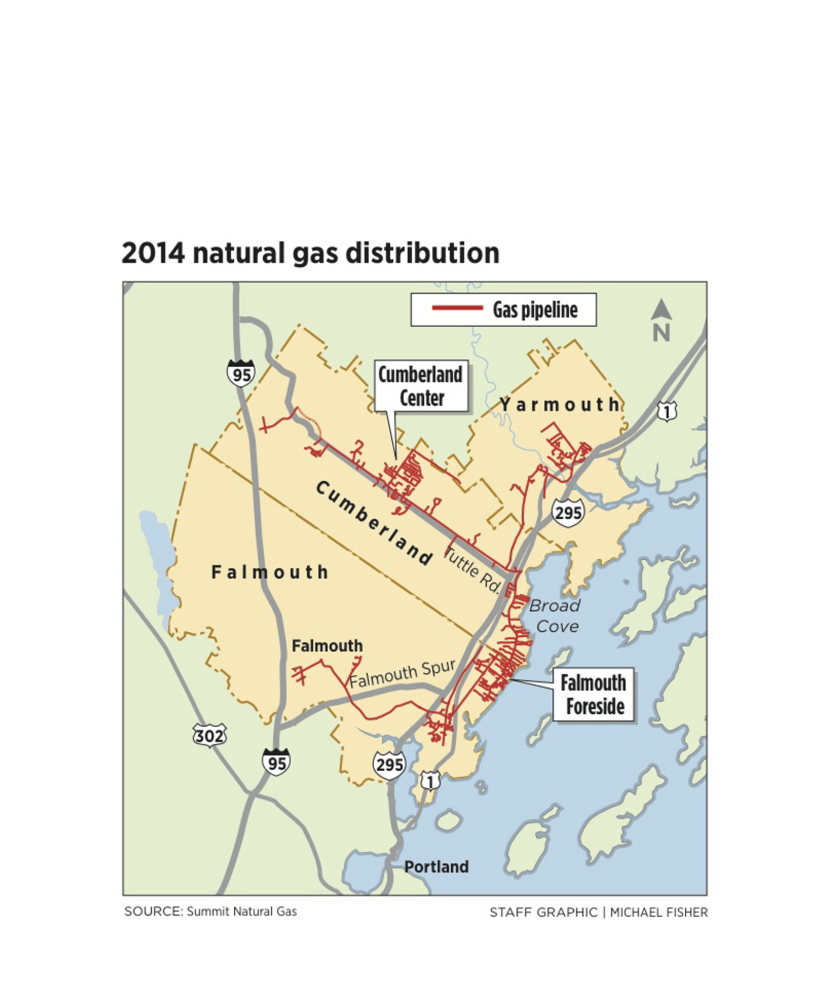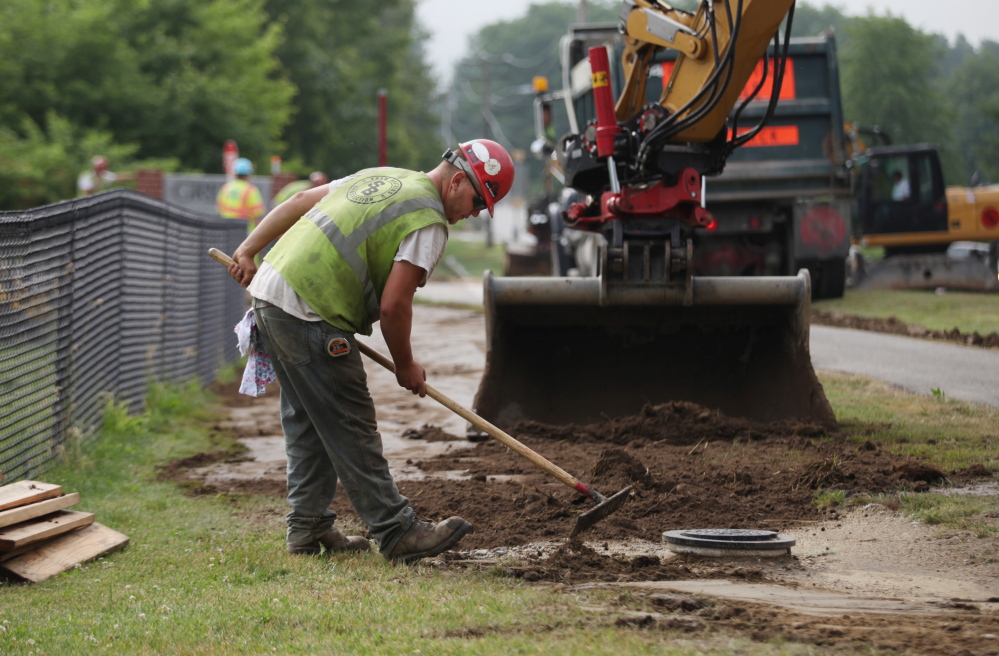CUMBERLAND — Work crews are laying underground pipe along sections of Blanchard and Tuttle roads and Route 9, establishing the backbone of a highly anticipated natural gas network that will be built in Cumberland, Yarmouth and Falmouth over the next several years.
The construction is the latest and most outward sign of progress in a three-year effort, led by Cumberland officials, to deliver natural gas and significant savings to homes and businesses in the three coastal communities. A growing number of residents, meanwhile, are weighing the costs and benefits of hooking up to gas when it arrives in their neighborhoods.
Weather delays and other construction challenges have prompted Summit Natural Gas of Maine to curb the scope of work to be done in 2014, according to town officials and Mike Duguay, Summit’s director of business development. Construction this year started in mid-May, about six weeks later than planned, said Cumberland Town Manager Bill Shane.
Faced with growing anticipation – and despite concerns about the project’s speed – the company still expects to meet its “linear footage goal for 2014” and provide natural gas in some areas of all three towns before the start of the next heating season.
“It’s an updated footprint that we feel we can complete this year,” Duguay said. “This is a multi-year project. Our intent is to get 80 percent penetration in the communities within five years. Residents need to have a little patience.”
Duguay declined to provide a copy of the updated construction footprint or details of the linear footage goal, saying that a color-coded map published earlier this year still reflects the basic expanding scope of the project in 2014, 2015, 2016 and beyond.
If properties appear to be where the pipeline is scheduled to be installed this year, property owners should contact Summit for information on how and when they should convert their heating systems to accommodate natural gas.
By last week, Summit and its subcontractors were installing the main line along three major roads in Cumberland, with distribution lines along side roads and service lines to homes on streets such as Pinewood, Hedgerow, Farwell, Woodside, Candlewick, Friar and Drowne, according to recent construction updates. Some homes in Cumberland will have gas service by Labor Day, Shane said.
In the coming weeks, crews also will begin installing pipe in Yarmouth and Falmouth, with gas service expected to start in late October or early November, though residents in outlying areas of these town won’t see pipelines in their neighborhoods for years, Duguay said.
“It’s going to take a few construction seasons to get there,” he said.
Summit is expected to connect about 9,000 customers within five years and install as much as $100 million in taxable infrastructure throughout the three towns, Shane said. Customers would pay the cost of installing pipe through gas rates.
So far, interest in all three communities has been strong, according to town officials.
“The challenge will be to get homeowners to convert existing heating systems to natural gas,” Shane said.
Replacing an older furnace or boiler can cost $7,000 to $12,000, he said. Replacing an oil burner on a furnace or boiler that’s less than a decade old can cost as much as $4,000, including a new chimney liner. Converting a propane burner will cost less than $1,000, he said.
On the upside, homeowners who switch to natural gas can expect to save about 40 percent on annual fuel costs – an average of $1,130 per year or about $94 per month.
Shane, who lives in Cumberland and plans to convert his oil furnace and two propane fireplaces to natural gas, figures he’ll save about $2,000 per year and recoup his conversion costs in three to five years.
“It’s awesome,” Shane said. “I’ll be connected before Columbus Day.”
Both Summit and Cumberland have extensive websites offering assistance and information about the conversion process, related costs and financing incentives and rebates provided through Efficiency Maine and other sources.
Despite guaranteed savings, deciding whether to convert isn’t easy for everyone.
Carolyn and George Small, both in their 70s, live in the house he built on Tuttle Road in the 1960s. They’re not sure it makes sense to replace their 20-year-old oil furnace, even though their annual fuel costs average about $3,500.
“At our age, it would be a big expense,” Carolyn Small said. “We’ve talked with a plumber, who happens to be our nephew, and we’re not sure it’s worth it.”
Just down the road, Darcy and Bill James know they won’t be tapping the gas line.
Their 2-year-old, superinsulated, passive solar home is highly energy-efficient, so they already spend little to heat with a pellet stove, Darcy James said. But Bill’s parents, Carole and Fred James, who live next door, can’t wait to switch their heating system from oil to natural gas, Darcy James said.
The prospect of significant savings has some people converting their heating systems months, even years, ahead.
Sam Eddy jumped at the chance to reduce the $4,000 to $5,000 annual heating bill for his 1860 Greek Revival home on Bridge Street in Yarmouth.
Eddy replaced his 40-year-old oil furnace in May, a year before natural gas lines are expected to be installed in his neighborhood.
“It was dying a slow death,” Eddy said. “So I opted to replace it.”
Eddy had a new propane boiler installed for about $10,000, and it will cost a few hundred dollars to convert its burner to natural gas when the time comes, he said.
When natural gas arrives in his neighborhood, Eddy expects his annual heating costs to fall to about $2,500, he said.
“It’s going to be a game-changer,” Eddy said. “With savings like that, I’ll be able to recover the cost of a new boiler within five years.”
Send questions/comments to the editors.




Success. Please wait for the page to reload. If the page does not reload within 5 seconds, please refresh the page.
Enter your email and password to access comments.
Hi, to comment on stories you must . This profile is in addition to your subscription and website login.
Already have a commenting profile? .
Invalid username/password.
Please check your email to confirm and complete your registration.
Only subscribers are eligible to post comments. Please subscribe or login first for digital access. Here’s why.
Use the form below to reset your password. When you've submitted your account email, we will send an email with a reset code.